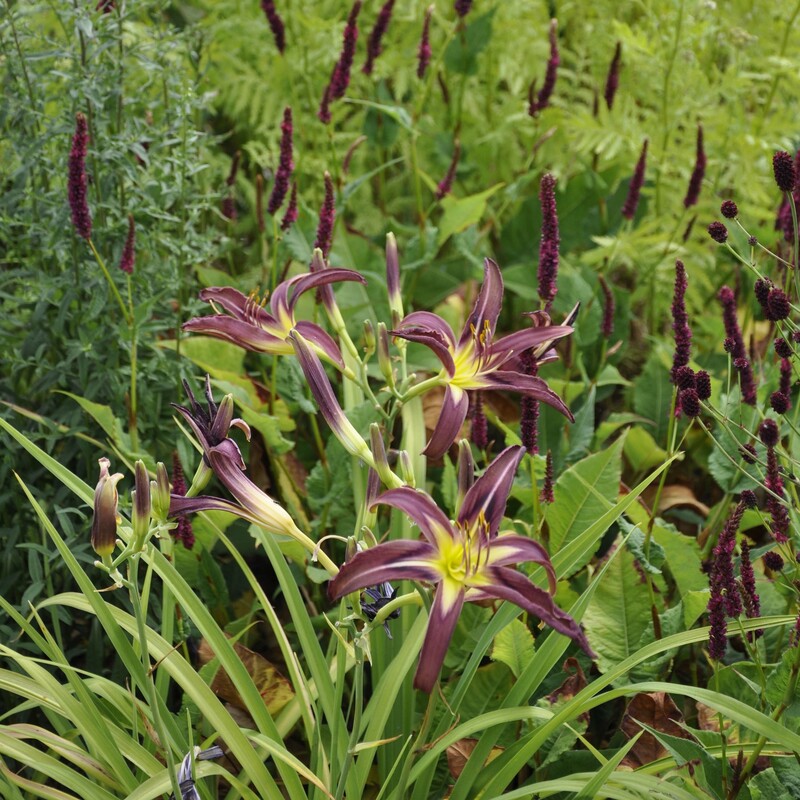What Is A Perennial
A perennial plant is a herbaceous plant that does not have woody stems, unlike trees and shrubs. Although they are very hardy, the leaves of the vast majority of perennials die back in autumn and emerge again in spring. Some perennials such as Bergenia are evergreen, which means some or most leaves remain all year. They are very easy to grow and easy to look after on average. Whether you want a cottage garden look, a bee friendly plant sanctuary, or a modern prairie style grass garden, there is a plant to suit every need. This means a garden can be in flower all summer by planting even a small range of perennials according to the month they bloom.
You can buy perennials online from us in a wide variety of styles, here are just a few of our favourites:
Fluffy Sanguisorba with hardy geraniums, Geum with other spring flowers, elegant Veronicastrum, evergreen Bergenia, ground-covering hardy geraniums
Why Grow Hardy Perennials
There are many reasons to grow perennial plants. They are easy to grow and easy to look after. The flowers are colourful and very varied in shape, and perennials are excellent for attracting feeding bees and butterflies, as well as other flying insects. They also make wonderful cut flowers for the house.
Here are a few specific reasons for growing perennials:
Echinaceas attract wildlife, most perennials can be cut and put in a vase, Centaurea are very bee friendly plants in the spring, Erigeron Karvinskianus flowers all summer and will seed around even in a container, and hardy geraniums can be grown in hanging baskets, perfect for gardens with limited space.
When Do Perennials Flower
There is a perennial for every month and every season of the year. The earliest to bloom are Hellebores, followed quickly by spring flowering perennials like Digitalis (foxgloves), Centaurea (Perennial cornflower) and Geum (Avens). The majority of perennials come into flower during May, June and July, when lovely plants like Peonies, Iris, Campanula (Bellflower), Salvia, Dianthus, Hardy Geraniums and Lupins are in full flower. August to September perennials provide the late summer to early autumn garden with loads of richly colour flowers. Phlox, Echinacea (Coneflower), Helenium (Sneezeweed) and Verbena will bloom continuously for months attracting bees snf butterflies into the garden. Many perennials are in flower by the time autumn is in full swing. Brightly coloured Aster, pink and white Japanese Anemone, Sedum (Ice plant), Rudbeckia (Black eyed-susan) and Eupatorium (Joe-pye weed) that range in height from very small or very tall.
There are thousands of different perennials to choose from, here are just a handful of classic types:
Winter-flowering Helleborus foetidus, spring-blooming Aquilegia, high-summer Achillea, autumn essential Asters, long-flowering Hardy Geraniums
Perennials For Colour
You can buy perennials in a vast wide range of colours and tones. There are white perennials, soft to dark pink and blue perennials that combine easily into a cottage garden. Brightly coloured perennials ranging from yellow to red and orange perennials and rich purple will brighten up a late summer or an autumn garden. The leaves also vary. Some have big leaves, others can be quite small. Although the colour of leaves ranges from soft green to dark green, some have silver leaves, and some turn shades of red in autumn.
Colour makes all the difference to a garden:
Orange flowers can be dramatic, cool whites and silvers can be found in both flowers and leaves, purple and lilac flowers blend with many other colours, late summer flowers come in tones of red
Where Perennials Grow
We supply mail order plant deliveries in pots or with bare roots which can be grown in all locations found around the garden. While most like a well-drained soil, some, such as Astilbe and tall Primulas, don’t mind a clay or wet soil. Lots of perennials will grow in dry soil, including succulent Sedum (Ice plant) and silver-leaved perennials like Stachys byzantina. Just about all perennials will grow in full sun, but if you are looking for plants that grow in shade, perennials have much to offer. Euphorbia (Spurge), many Hardy Geraniums, Helleborus, Hemerocallis (Daylily) and Hostas are among the many that don’t mind a shadier spot such as that found under the shade of trees.
When Can I Plant Perennials And How Many Do I Need?
We sell most of our bee friendly plants and perennials all year round in pots so they can be planted at any time of the year. Although we sell Peonies and irises in pots, the vast majority are sold as bare rooted plants lifted from the ground in autumn (see Peonies and Irises). While the general wisdom is to plant perennials in quantities of 3 to create impact in a shorter time, larger plants such as Aruncus and tall Rudbeckia can be grown in single numbers. To decide how many plants you need to fill an area simply look at the spread of a plant. Planting instructions are sent with all orders.
Caring For Perennial Plants
Perennials like the hardy geranium are very easy to look after. Most varieties need very little attention for much of the year, as long as the soil is free of weeds when the plants start to grow in spring. The foliage of most perennials starts to decline in late October. The old top growth, including leaves and flower stems, can be removed at any time before new growth starts to emerge in early spring. On the whole perennials do not need fertilising but a few might need staking to stop them falling over other plants, otherwise they are very easy to care for.
For more information Claire Austin's Book of Perennials is a useful read




















